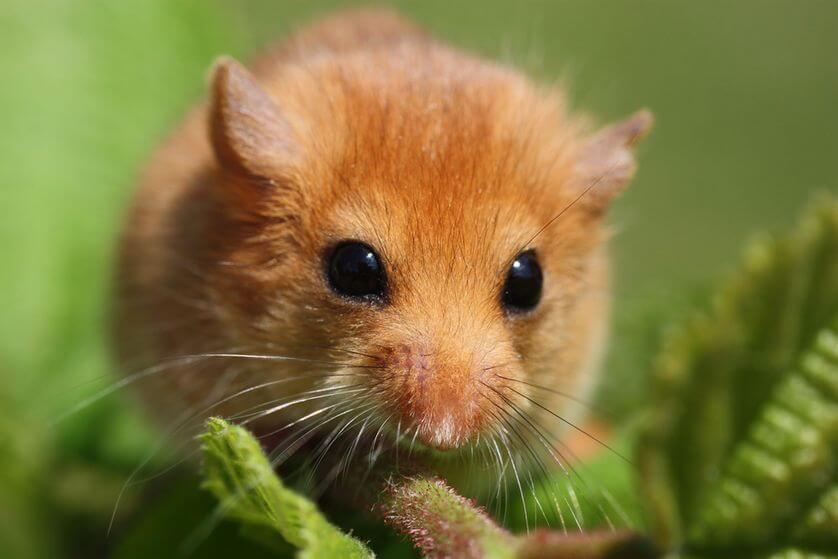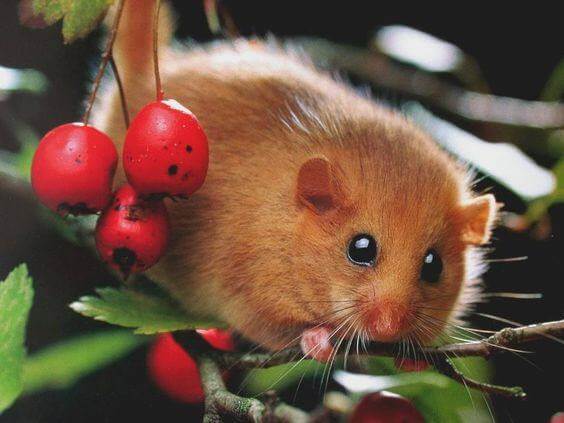Dormouse is a rodent of a family Gliridae, they are generally found in Europe, however, some species of dormouse also lives in Africa as well as in Asia. It is a nocturnal animal and is particularly known for their long periods of hibernation. This creature is the only species which is native to the British Isles. In everyday life “dormouse” can refer either to that one species or to the family as a whole.
Dormouse Facts
- Dormice are the small rodents, usually, their body length lies between 6 to 19 cm (2.4 to 7.5 inches) and their weight ranges in between 15 to 180 gram
- In appearance, they look like mouse but they are furred in spite of being scaly
- They have an excellent sense of hearing and a wide variety of vocalisations
- Dormouse is having a dental formula similar to squirrels.

Diet
Dormice are omnivores and they typically feed on fruits, berries, flowers, nuts and insects. They are unique among rodents in which they lack a cecum which is a part of gut in other species which is used to ferment vegetable matter. They have the requirement of a wide range of arboreal food.
They feed on berries and nuts and hazelnuts being the main food for fattening before hibernation. The dormouse also eats hornbeam and blackthorn fruit, unlike hazels, which tend to avoid them. They also consume other food sources like buds of young leaves and flowers rich in nectar and pollen grains. They are also dependent upon other small insects which are primarily found on trees particularly like aphids and caterpillars.
Also read:
Habitat
They are usually used to live in dense, deciduous, woodland and many other types of forests like coppice and thick shrubbery. Dormice are used to build spherical grass and honeysuckle nests especially in coppice type of forests to have a habitat of their own, Dormice are usually afraid from going on high heights so their nests are situated a few feet above from the ground.

Behaviour
These are most charming, rare, and endangered among the Britain’s range of small mammals. They are basically shy & reserved and strictly having nocturnal habits in there regular life. In simple words, we can also say that they have basically displayed unusually bold behaviour.
Life style
The life strategy of the hazel dormouse is to hibernate at ground level over winter and then to spend their spring, summer and autumn seasons actively in the tree and canopies. At the time of waking up from hibernation around the month of April, dormice take all the advantages of early buds, flowers and small insects to feed and also to regain some weight which they had lost during hibernation.
Mating starts taking place as early as May and after a gestation period of about three weeks, their first litters can be born in late May or in the beginning of the month of June.

Life Cycle
Their early litters are relatively unusual and their mating usually occurs either in June or July, their majority of litters are born either in July or in August. Their litter size is approximately 4 cm, they are literally blind at the time when they first came in this world and at the same time they are pink and naked at the same time when they are coming place in the world.
The young dormice are being kept inside the nest at least for four weeks and they are being cared by their mother for those four weeks and after these weeks they are made independent to move on in their life.
In short we can explain the life cycle of a dormouse as the following
- Grey in colour with blind or closed eyes
- Grey in colour but with opened eyes
- Juvenile
- Adults
Predators
Dormouse is used to live at low densities, even in their ideal habitat which are not generally predated. They are however eaten by owls, weasels, grey squirrels and cats since they are active. They are eaten by badgers and wild boar at the time of their hibernation at the ground level because they are afraid of going on high heights. It is likely the greatest threat to an individual dormouse throughout their winter survival.
Appearance
A dormouse ordinarily have golden-brown coloured fur, they usually appears with large eyes, ears and also with a long furry tail. They usually have such a soft fur which is really so soft and it is so light weighted which have an approximate weight of 1 to 2 grams.
Life Span
A dormouse has a life expectancy of around 3 years. It is expected that they at least live alive for 3 years and at maximum their life expectancy is 4 years. Their life expectancy can’t be more than 4 years as they cannot face so extreme weather conditions.

Health issues
The key issues which a dormouse faces throughout their lifespan is that when they fell ill or faces disease then it is very difficult for them to overcome the difficulties and weaknesses which they had got from their health issues. It is difficult because they spend a lot of time in hibernation. If in case any dormouse faces any health issue just before going into hibernation then it will be very difficult for them to recover from their health issues.
Also read:
Dormouse Characteristics
- They are afraid of going to high heights
- They are used to live on low densities
- They can climb the feeder along the blades of nearby pampas grass
- They are omnivores
- They are mouse like in appearance
- They are unique among rodents
- They usually breed once or twice in a year
- They are completely hair less when they are born
- They typically become sexually mature at the end of their first hibernation respectively after their birth
- They live in small family groups
- They decide their place to live which is dependent upon the availability of food in that particular area
- They decide their own place for hibernation which is dependent upon the temperature of the respective place
- Dormouse are usually shy in nature






